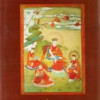Previously we blogged about the new book by Sylvia Wong, “The Karmapa Prophecies“. Now there is a website www.thekarmapaprophecies.com which contains further information about the book.
The website reproduces the introduction to the new book. Here is an excerpt:
Part One: On Prophecies and Visions
To help sort out the competing claims in the current controversy, I believe that “an unbiased voice” can be found in the past – namely, the prophetic words of previous Karmapas.
Karmapa’s followers believe he is a great bodhisattva, whose mind is synonymous with clarity and wisdom. Many also believe that Karmapa knew such a controversy would arise. Indeed, as the respected Gelugpa scholar Geshe Dawa Gyaltsen points out in Part One, the 5th Karmapa Dezhin Shegpa (1384-1415) and the 16th Karmapa Rangjung Rigpe Dorje (1924-1981) both prophesied a rift within the Karma Kagyu.
Here are the words of the 16th Karmapa:
“In its heart, the duck relied on the lake
but the shameless lake brought ice, its partner, and became sealed.”At first glance, these words may seem like lines from a poem and nothing more. However, Geshe’s insight into the passages paints a different picture. Could the 16th Karmapa be referring here to a betrayal that would keep him away from his home base at Rumtek Monastery?
Another powerful message is found in a prophecy of the 5th Karmapa. He predicted that someone with the name “natha” would come close to obliterating the Karma Kagyu lineage and doctrines.
A great deal of confusion has arisen from the translation of the word “natha”. Situ Rinpoche’s supporters have suggested it means “nephew,” in order to implicate Shamarpa, who is the nephew of the 16th Karmapa. Tibetan scholars usually write in Sanskrit and/or Tibetan; “natha” does not mean nephew in either of these languages – nor, indeed, in any language I have come across. In fact, “natha” is a Sanskrit word whose Tibetan equivalent is “gon”. As it happens, part of Situ Rinpoche’s full Tibetan name is Jam-gon. A detailed explanation of this word is given at the end of Chapter 1, which includes the definition of “natha” found in Sarat Chandra Das Tibetan-English Dictionary.
When I began this project, I wanted to understand what the previous Karmapas had foretold. I set out to obtain copies of the original Tibetan books, or “pechas”. I then worked together with a group of Tibetan translators to translate them into English. It was at this time that it came to my attention that Geshe had analyzed the Karmapa prophecies and written his commentaries in Tibetan explaining their meaning. Geshe-la has an excellent command of classical Tibetan; his explanations are thus based on a precise understanding of the Karmapas’ words. To say that it caught my interest would be an understatement. I am grateful to my translators, who obtained Geshe Dawa Gyaltsen’s consent to have his commentaries translated and edited for this book. It is important that the Karmapas’ words be understood in the proper context in order to put the current controversy in perspective.
As I was finalizing the writing of this book in March of 2008, two books of predictions by Guru Rinpoche were submitted to Karmapa’s library in Kalimpong. In one of them is a prediction, which is by far the most convincing prophecy, as it actually names three individuals who are currently embroiled in the 17th Karmapa’s dispute. A precise translation of this prediction is presented in Chapter 4 along with Geshe Dawa Gyaltsen’s explanation on its meaning, as well as his interpretation on the identities of the three individuals.
The book is available to order at the Wisdom Books website and anyone with an interest in the controversy surrounding the recognition of the 17th Karmapa is encouraged to read it.




 Follow
Follow